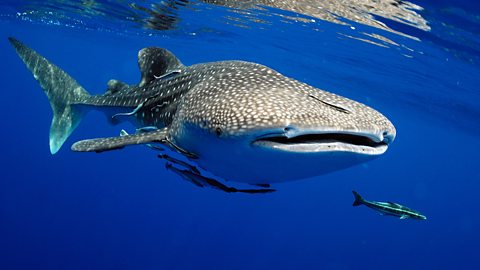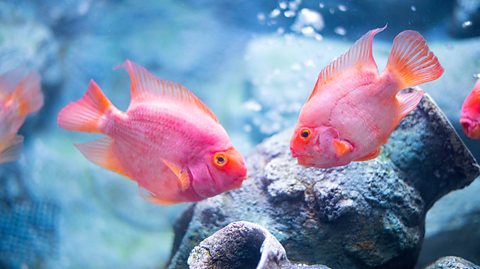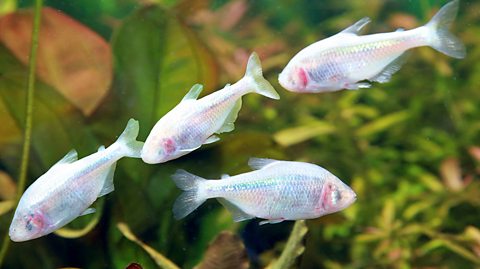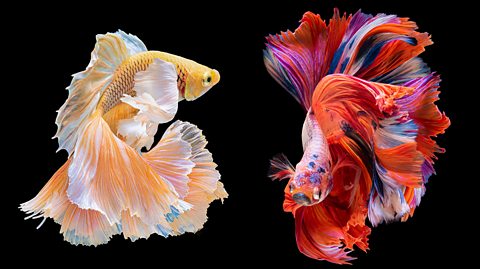Explore fish with these 5 fascinating facts!
Let’s take a deep dive and uncover five intriguing facts about fish. From their communication skills to their breath-taking behaviours, we’ll delve into the world of fish!
1: What is the biggest fish in the world?
The whale shark is the biggest fish in the world. If their usual length of 12 metres wasn’t enough, the largest whale shark ever discovered was an unbelievable 20 metres in length and 20 tonnes. That’s just 3 metres short of a tennis court and around the weight of a loaded bus!
Although it has both “whale” and “shark” in its name, the whale shark is actually a shark, which is a type of fish. Whales are mammals, and this enormous animal earns the name whale solely because of its staggering size.
Despite their size, if you were to come across these colossal creatures in their tropical homes off the coast of India, the Maldives or Western Australia, whale sharks are known to be gentle giants who present extremely little danger to the scuba divers who frequently come to swim alongside them.
Bonus fish fact: The whale shark is estimated to live up to 100 years. However, that’s nowhere near as old as the fish with the longest lifespan in the world – see fact #5 for that.

2: How do fish communicate?
Would you ever believe that there are fish in the sea having a chat right now? Well, they (sort of) are. Although it sounds like something out of Finding Nemo, scientists from Cornell University studied the sounds that fish make and found that at least 175 types of fish use noises from their body for what we think is communication.
The researchers found that many of the sounds fish make are not simply caused by eating or moving around but are used to say hello to their fishy friends. This is called soniferous behaviour. The experiment found that one type of fish, called the sweeper, lets out a sound known as a ‘contact call’, which scientist Aaron Rice describes as meaning something like “Hey, I’m over here!” There might be many other things these talkative tailed creatures have to say to one another though, with Mr Rice also saying that “there are a bunch of calls where we’re not sure what the behavioural role of the sound is.”
Don’t think that all these fish are having a quiet chat, either: certain fish, such as the black drum, let out calls that are 165 decibels, which is louder than a firework and can be heard up to 10km away.

3: The Antarctic toothfish produces antifreeze
Yes, you read that right. Known for being able to withstand the coldest temperatures of any fish, the preferred temperature of this hardy creature is a freezing cold -1.5 – 1.3 °C - below the temperature at which water freezes. This is so cold that the Antarctic toothfish has to produce antifreeze glycoproteins to stop its own blood freezing in the sub-zero conditions of its home in the Southern Ocean that surrounds the Antarctic. Just like the antifreeze your relatives might use to defrost the ice on their car, the antifreeze produced by the Antarctic toothfish lowers the freezing point of a liquid, in this case its blood.
Another way this incredible creature withstands these icy conditions is by having an enormous appetite. Feeding mainly on shrimp and small fish, the Antarctic toothfish warms itself up by making sure that it is constantly digesting food.
Since ice covers the parts of the ocean where the Antarctic toothfish live, its eyes have adapted to be able to see in very dark waters where humans would find it very difficult.
4: The Mexican tetra fish can repair its own heart

If you thought regeneration was reserved for sci-fi series such as Doctor Who, think again. The Mexican tetra fish can repair its own damaged heart tissue. Despite the fact that it is impossible for humans to regenerate their own hearts, scientists have found that the ingenious gene present in the Mexican tetra fish is in fact shared by humans.
This has led to exciting research that could hopefully make it possible to heal heart muscle in patients who have had heart attacks, by artificially modifying how the gene (called lrrc10) works in humans. If successful, this could help over a million people in the UK who are currently living with a damaged heart after suffering a heart attack.

5: What is the oldest fish in the world?
The Greenland shark is the fish with the longest lifespan in the world and in fact the oldest vertebrate. In 2016, scientists found one female Greenland shark that they estimate to be around 400 years old.
To give you an idea of how long ago that is, this big fish is said to be born the same year that William Shakespeare died, in 1616! I can't image there's a birthday cake big enough to fit all the candles!
Where can I read more about living things in the ocean?

If these facts have got your curiosity swimming, why not delve deeper into the world’s oceans by checking out our Regenerators articles such as What is the most intelligent animal in our oceans? and, How can some ocean animals avoid predators?
We should all aim to protect our oceans and keep them clean. Read more about ocean pollution and find out why our oceans are important.
